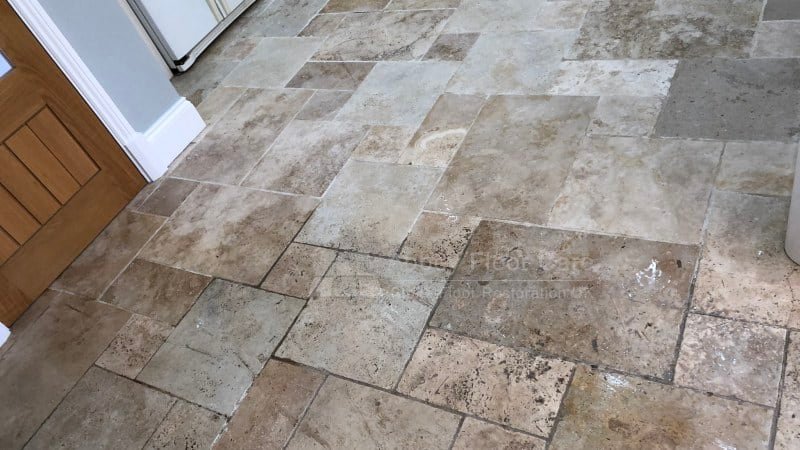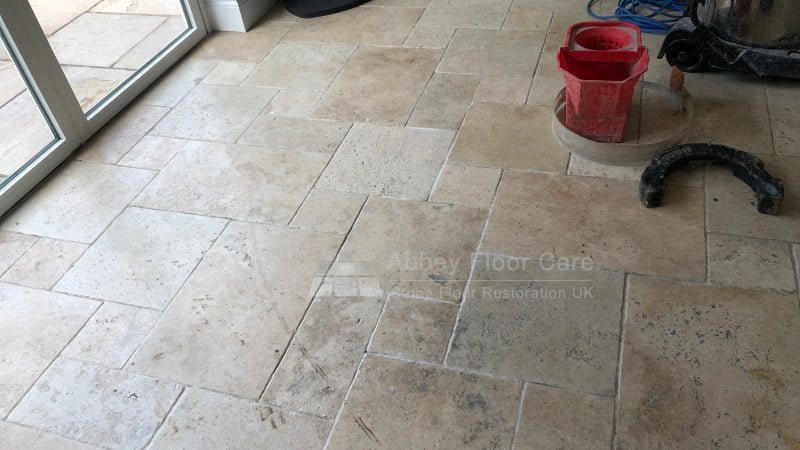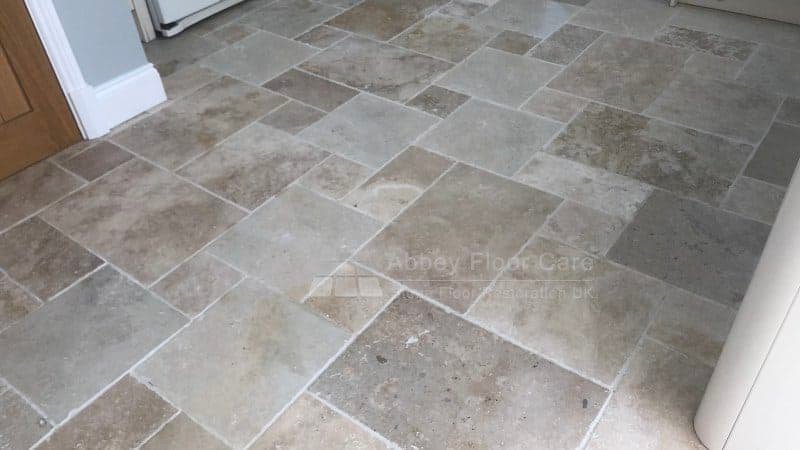
Cleaning And Sealing A Limestone Floor In Thurnby Leicestershire
Last Updated on January 15, 2021 by David
I was contacted by a customer in Thurnby, Leicestershire, who was very disappointed with the Limestone floor in their new home. The Limestone floor looked dull, dirty and generally uninviting.

Ingrained surface soil made the Limestone look dull. There was plenty of soil in the grout and the holes After discussing the various restoration options, we agreed on the most suitable option and agreed on a start date.
Client Comments: My wife is thrilled with the floor. It looks so much better now it has been cleaned.
Deep Cleaning The Limestone Floor
Most of the soil in Limestone grout and natural holes originate from mopping with a wet cotton mop. If you don’t remove dry soil from a stone floor, wet mopping turns the dry soil into a dirty wet paste.
When a wet- mop moves over the floor, grit particles in the slurry paste scratch the surface of the floor. The mop also deposits dirty slurry into grout lines and holes.
Over time, the slurry deposits build-up, turning the clean holes into ugly visible black spots.
I started by removing the surface soil with a rotary scrubbing machine and Limestone cleaners. I rinsed the slurry with my powerful wet vacuum. I repeated the scrubbing until the scrubbing had removed all the soil it could.
The scrubbing machine could not reach the impacted soil in the holes in the tiles and the grout. I removed the impacted soil by pressure rinsing the floor with my “Rinse and Capture” equipment.

Grout Filling The Floor
I filled the holes in the Limestone tiles with a Jasmine colour grout. The grout work is quite lengthy, taking me a full day because I grouted each tile individually.
As the grout dried, I carefully removed the surface grout, leaving a lovely finish.

I managed to fill most of the holes with grout. Now the tiles won’t suffer from ugly impacted soil.
Seal Limestone With Primer Sealer
My finishing sealer gives the natural stone a wet-look, without the gloss, enhancing the natural colours in the stone. My clients wanted to retain the light look of the Limestone. So, I applied a primer-sealer to minimise the colour-enhancing effect of the finishing sealer.
Limestone Sealing With Finishing Sealer
Initially, an impregnating sealer was applied to protect the floor. Impregnating sealers are used to protect all types of stone, but they do not make rough stone any easier to mop.
The surface of the stone remains rough, like sandpaper. It is challenging to mop a sandpaper-like rough finish on Limestone.
The finishing sealer I applied is a hybrid Impregnating and film-forming sealer. The sealer soaks deep into the surface of the stone. The resins in the sealer help bind the stone particles, increasing the durability of the finish.

The sealer is also film-forming. The thin surface film is hardly noticeable, but it makes the rough Limestone finish and grout more comfortable to mop clean. The film is exceptionally hard-wearing, giving years of life, rather than just months.
If you are looking for Limestone cleaning, please drop me a line, I am happy to help
Recent Posts:
We work throughout the country, just some of our work counties:
Copyright © Fabritec - Abbey Floor Care. Natural Stone Floor Restoration in Surrey and South West London FAQ - Privacy Policy - Terms And Conditions